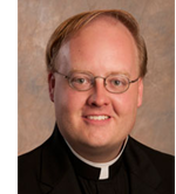|
If you recall, last year I wrote a series of bulletin articles on the Sacraments – looking at each sacrament through the lens of the theological axiom “lex orandi, lex credendi” (the law of prayer is the law of belief). This is a method of understanding the sacraments by looking at the rituals by which they are celebrated. We also took a look at the scriptural roots of each sacrament, the matter and form of each sacrament, and finally looked at the effects of the sacraments. I mentioned at the end of the last academic year that we had already examined five of the seven sacraments and planned to complete that look by examining the Sacrament of Matrimony and the Sacrament of Holy Orders. In picking up where we left off last year we are now going to turn to the Sacrament of Matrimony. First we will examine it in light of its scriptural basis, then examine its matter and form before moving on to the marriage ritual itself and then addressing a couple of important topics related to marriage.
To begin with, we see throughout scripture, numerous metaphors and comparisons used to describe God’s relationship with people – we may think of the Good Shepherd and the flock, or we may think of the Body of Christ with its various parts as some of the most familiar. One of the clearest metaphors that is used is the image of the bride and the groom. In the Old Testament, particularly in the prophets, we see the relationship between God and Israel compared to the relationship between a groom and a bride. We see in Jeremiah God directly referring to Himself as the husband of Israel, “for I am your husband” (Jeremiah 3:14, Douay-Rheims). We see this analogy playing a major role in the book of Hosea and perhaps one of the most haunting and memorable uses of this can be seen in Ezekiel Chapter 16. This use of this metaphor is carried on into the New Testament, however in the New Testament it is further refined and used to express the love and the relationship between Christ and the Church. We see St. John the Baptist discuss this and use the image of the groom to describe Christ’s relationship to the Church (John 3.29). We also see a reference by Christ Himself to His role as the Bridegroom in the Parable of the Ten Virgins (cf. Matthew 25.1-13). It is St. Paul who takes this metaphor and explains it theologically in his letter to the Ephesians where he speaks of the relationship between husband and wife and then directly points out that he is doing this in order to show us, “a great mystery” – one which he speaks “in reference to Christ and the Church.” (cf. Ephesians 5.22-33). So it is clear from scripture that in order to understand marriage we must understand how God and His people, how Christ and His Church are bound to one another. If a husband and wife are related to one another as Christ is to His Church then what do we see as the defining characteristics of that relationship? The Church points us to three – fidelity, permanence and fruitfulness, flowing from the bond of love. Just as Christ is bound to the Church faithfully, permanently and with a great fruitfulness, so too should a husband and wife be bound together, in love, faithfully, permanently and with great fruitfulness. This points out one of the fundamental ends of marriage, to reveal to the world the love that Christ has for His Church! The Nuptial Mass itself speaks of this great calling when it prays in one of the collects, “O God, who consecrated the bond of Marriage by so great a mystery that in the wedding covenant you foreshadow the Sacrament of Christ and his Church…” and in one of the Prefaces we hear, “the Sacrament of holy Matrimony” is “the abiding sign of your [God’s] own love.” Perhaps the clearest (and one of the most beautiful) references is found in one of the Nuptial Blessings, “O God, who, to reveal the great design you formed in your love, willed that the love of spouses for each other should foreshadow the covenant you graciously made with your people, so that, by fulfillment of the sacramental sign, the mystical marriage of Christ with his Church might become manifest in the union of husband and wife among your faithful.” What a beautiful and noble gift marriage is! (This article is part of a series of articles on The Sacraments which will appear in the bulletin over the course of this year.) Comments are closed.
|
Fr. PeterArchives
June 2023
Categories |
Join us at MassSaturday at 4pm;
Sunday at 7:30am, 9:00am, 10:30am Daily Masses: Monday-Friday 6:30am Tuesday/Friday 8::00am (school days only) Saturdays 8:00am Sacrament of Reconciliation |
|


 RSS Feed
RSS Feed
